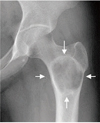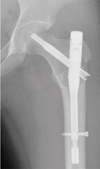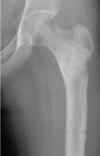Abstract
We report the case of a 25-year-old woman presenting with left hip pain. A lesion was found in the proximal femoral metaphysis. Benign bone tumor, such as intraosseous lipoma or liposclerosing myxofibrous tumor, was suspected based on simple radiographs and magnetic resonance images. Curettage of the lesion and bone grafting was performed. Histologic findings reflected primary intraosseous xanthoma of the proximal femur. Laboratory tests revealed the patient to be normolipidemic, while immunoelectrophoretic fractionation of lipoproteins revealed normal values for alpha, pre-beta, beta, and chylomicrons. At the one-year follow-up, there was no evidence of local recurrence. This is the first reported case of primary intraosseous xanthoma of the proximal femur in a normolipidemic patient.
Xanthoma is an abnormal deposition of cholesterol or triglycerides, which can occur in any part of the body and in many different disease states. These lesions contain abundant foamy histiocytes, and most commonly occur in superficial soft tissue, such as skin, subcutaneous fat, or tendon sheaths1).
Primary intraosseous xanthoma (PIX) is very rare2), and, as such, its predictors, such as age, sex, and race, are not well known. They have been reported in the appendicular skeleton, including the tibia, calcaneus, and humerus. Although several cases of PIX have been reported, they usually occurred in the setting of hyperlipidemia, especially primary or familial3). To our knowledge, no case of PIX of the proximal femur in a normolipidemic patient has been reported. Here, we report the case of a 25-year-old normolipidemic woman presenting with PIX of the proximal femur.
Permission was obtained from the patient included in this report.
In June 2014, a 25-year-old woman presented to the outpatient clinic with a 6-month history of progressive left hip pain. She had no history of recent trauma or fall. The pain was worse during activity. Physical examination revealed mild pain with motion in the hip joint and slightly limited range of motion.
Radiographs showed a large osteolytic lesion with well-defined margins in the proximal metaphysis of the femur, partially surrounded by sclerotic cortical bone (Fig. 1). Magnetic resonance imaging (MRI) showed a well-demarcated intra-osseous lesion measuring 58×42×42 mm. T1-weighted images demonstrated a lesion with heterogeneously distributed low- and high-signal intensities, while T2-weighted images revealed similar findings, partially surrounded by areas of low signal intensity, concordant with reactive bone sclerosis. Fat-suppressed images showed an area of low signal intensity at the center of the lesion. A radionuclide bone scan demonstrated a lesion with peripherally increased uptake of Tc-99 m methyl diphosphonate (MDP) in the metaphysis of the femur in the area of radiographic abnormality (Fig. 2). These findings reflected benign bone tumor, such as intraosseous lipoma or liposclerosing myxofibrous tumor, rather than fibrous dysplasia, giant cell tumor, aneurysmal bone cyst, or simple bone cyst.
Because the lesion was suspected to be a benign bone tumor with progressive pain leading to impending fracture, surgery was performed in August 2014. Curettage of the lesion and bone grafting were performed with a femoral head allograft, which was stored in our bone bank. Prophylactic internal fixation using the Zimmer Natural Nail System (Zimmer, Warsaw, IN, USA) was performed to prevent pathologic fracture (Fig. 3). Macroscopically, the pathologic specimen had abundant tan-brown soft tissue and multiple bone fragments. Histologically, the lesion consisted of many histiocytes, frequently forming giant cells. These histiocytes showed abundant foamy cytoplasm, and were positive for CD68 but negative for CD1a and S100 (Fig. 4). These histopathologic findings reflected either lipid granulomatosis or xanthomatosis of bone.
After surgery, we evaluated the lipidemic status of the patient including her family history. She had no relevant history of elevated laboratory results, but her mother did have a history of hyperlipidemia. Laboratory tests revealed the following results: fasting blood glucose, 95 g/dL; HbA1c, 5.4%; total cholesterol, 157 mg/dL; triglycerides, 63 mg/dL; high-density lipoprotein cholesterol, 44 mg/dL; and low-density lipoprotein cholesterol, 101 mg/dL. Immunoelectrophoretic fractionation of lipoprotein revealed normal values for alpha, pre-beta, beta, and chylomicrons.
One year after surgery, the patient's symptoms are relieved. Implant removal and bone grafting with allograft bone chip for new bone formation were performed to remove foreign body sensation. There was no sign of local recurrence and the patient could successfully perform normal activities at the last follow-up (Fig. 5).
PIX is an extremely rare, benign bone tumor that usually occurs in the appendicular skeleton, such as the calcaneus, rather than the axial skeleton. Most PIXs occur in patients with hyperlipidemia. The lesion in this patient showed a sharply defined lytic lesion with a narrow zone of transition, and partially or completely sclerotic margins. These characteristics also are seen in intraosseous lipoma, liposclerosing myxofibrous tumor, simple bone cyst, aneurysmal bone cyst, non-ossifying fibroma, chondroblastoma, giant cell tumor, and fibrous dysplasia. The location of the lesion made it difficult to include PIX in the differential diagnosis preoperatively.
PIX can exhibit an aggressive appearance, with an expansile border or cortical disruption, and may mimic malignancy, such as multiple myeloma or metastatic bone tumor3). Whole-body bone scintigraphy typically shows increased uptake of Tc-99 m MDP4). MRI is typically characterized by a circumscribed area of heterogeneous signal intensity on T1- and T2-weighted images, and associated loss of signal when fat is suppressed, which is hypothesized to result from the cholesterol-laden histiocytes seen on histopathology5).
The typical histopathologic appearance of PIX is a lesion consisting of numerous foamy cells and non-foamy mononuclear or multinucleated giant cells, and, occasionally, Touton-type giant cells6). Abundant cholesterol clefts with giant cells at the focal area and cholesterol clefts between bone spicules also can be seen in the lesion7). In our case, we could see numerous foamy cells and multinucleated giant cells, but Touton-type giant cells and cholesterol clefts between bone spicules were not observed.
Giant cell tumor and intra-osseous lipoma might be considered in the differential diagnosis. Giant cell tumors usually show a lytic lesion in the epiphysis, rather than in the metaphysis, and sometimes grow to the articular surface. The key histopathologic appearance is multinucleated giant cells with up to 100 nuclei that have prominent nucleoli8). Intraosseous lipomas are usually located in the long bones and have radiologic findings similar to PIX. However, a well-defined lesion with sclerotic borders and mineralization of the central lesion are often pathognomonic. Computed tomography and MRI also can be diagnostic because they show high composition of fat content in the lesion9).
We could not determine the apparent pathophysiology of PIX in this patient. However, we suggest that this lesion is highly associated with familial factors because her mother had a history of hyperlipidemia. Further study is needed to investigate the specific genes associated with xanthoma in patients with a family history of hyperlipidemia.
When PIX is accompanied by progressive pain or aggressive appearance, the optimal treatment typically consists of curettage of the lesion and bone grafting10). The necessity of prophylactic internal fixation depends on the location and extent of the lesion. Because the pelvis, proximal femur, and tibia are particularly prone to pathologic fracture, internal fixation may be indicated. In this patient, although the lesion did not exhibit an aggressive appearance, it showed extensive osteolysis with thin cortical bone accompanied by progressive pain in the left proximal femur. Thus, internal fixation was performed to prevent pathologic fracture.
In conclusion, we report a rare case of PIX of the proximal femur in a patient without hyperlipidemia. This diagnosis can be difficult to make preoperatively using clinical examination, laboratory findings, and imaging studies. The variable clinical and radiologic characteristics of PIX reinforce the necessity of bone biopsy to confirm diagnosis.
Figures and Tables
 | Fig. 1Preoperative radiograph, showing a large osteolytic lesion with well-defined margins in the proximal metaphysis of the femur, partially surrounded by sclerotic cortical bone. |
 | Fig. 2Magnetic resonance images, showing a well-demarcated intra-osseous lesion measuring 58×42×42 mm. (A) Fat-suppressed image. (B) Fast spin-echo T2-weighted image. (C) T1-weighted image. (D) Radionuclide bone scan. |
 | Fig. 3Postoperative radiograph, showing curettage and bone grafting with a femoral head allograft. Prophylactic internal fixation was performed to prevent fracture. |
References
1. Ali S, Fedenko A, Syed AB, et al. Bilateral primary xanthoma of the humeri with pathologic fractures: A case report. World J Radiol. 2013; 5:345–348.

2. Dallari D, Marinelli A, Pellacani A, et al. Xanthoma of bone: first sign of hyperlipidemia type IIB: a case report. Clin Orthop Relat Res. 2003; (410):274–277.
3. Boisgard S, Bringer O, Aufauvre B, et al. Intraosseous xanthoma without lipid disorders Case-report and literature review. Joint Bone Spine. 2000; 67:71–74.
4. Kovac A, Kuo YZ, Sagar V. Radiographic and radioisotope evaluation of intra-osseous xanthoma. Br J Radiol. 1976; 49:281–285.

5. Yamamoto T, Kawamoto T, Marui T, et al. Multimodality imaging features of primary xanthoma of the calcaneus. Skeletal Radiol. 2003; 32:367–370.

7. Huang CF, Cheng SN, Hung CH, et al. Xanthoma of bone in a normolipidemic child: report of one case. Acta Paediatr Taiwan. 2000; 41:158–160.
8. Sobti A, Agrawal P, Agarwala S, Agarwal M. Giant cell tumor of bone - an overview. Arch Bone Jt Surg. 2016; 4:2–9.
9. Kapukaya A, Subasi M, Dabak N, Ozkul E. Osseous lipoma: eleven new cases and review of the literature. Acta Orthop Belg. 2006; 72:603–614.




 PDF
PDF ePub
ePub Citation
Citation Print
Print




 XML Download
XML Download